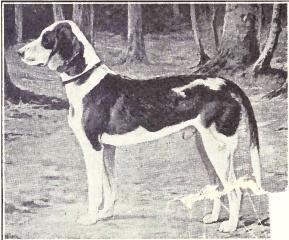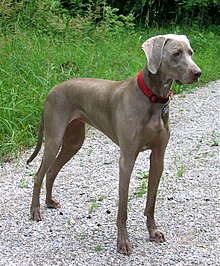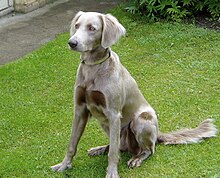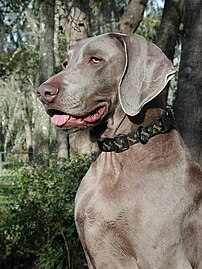
The Bichon Frisé or Bichon à Poil Frisé is a Franco-Belgian breed of small toy dog of bichon type. It was recognised by the Société Centrale Canine in 1933 and by the Fédération Cynologique Internationale in 1959.

The Vizsla, also known as Hungarian Vizsla, Magyar Vizsla or Hungarian Pointer, is a dog breed from Hungary and belongs to the Fédération Cynologique Internationale (FCI) group 7, the Canadian Kennel Club (CKC) group 1, and the American Kennel Club. The Hungarian or Magyar Vizsla or Smooth-Haired Vizsla are sporting dogs and loyal companions. The Vizsla's medium size is one of the breed's most appealing characteristics. As a hunter of fowl and upland game, the Vizsla has held a prominent position among sporting dogs – that of household companion and family dog.

The Affenpinscher is a German breed of small toy dog of Pinscher type. Originally developed as a mouser, the Affenpinscher is now commonly found as a companion worldwide.

The Fédération Cynologique Internationale is the largest international federation of national kennel clubs and purebred registries. The FCI is based in Thuin, Belgium and has 98 members and contract partners.

The Poodle, called the Pudel in German and the Caniche in French, is a breed of water dog. The breed is divided into four varieties based on size, the Standard Poodle, Medium Poodle, Miniature Poodle and Toy Poodle, although the Medium Poodle is not universally recognised. They have a distinctive thick, curly coat that comes in many colors and patterns, with only solid colors recognized by breed registries. Poodles are active and intelligent, and are particularly able to learn from humans. Poodles tend to live 10–18 years, with smaller varieties tending to live longer than larger ones.

The Black Russian Terrier, also known as the Chornyi Terrier, is a breed of dog created in USSR in Red Star Kennel during the late 1940s and the early 1950s for use as military/working dogs. At the present time, the Black Russian Terrier is a breed recognized by the FCI, AKC, CKC, KC, ANKC, NZKC and other cynological organizations. The contemporary Black Russian Terrier is a working dog, guarding dog, sporting and companion dog.

The Cane Corso is an Italian breed of mastiff. It is usually kept as a companion dog or guard dog; it may also be used to protect livestock. In the past it was used for hunting large game, and also to herd cattle.

The Schnauzer or Mittelschnauzer is a German breed of dog in the Pinscher and Schnauzer group. It is characterised by an abundant bristly beard and whiskers, usually lighter than the coat. It is one of three Schnauzer breeds, the others being the Giant Schnauzer or Riesenschnauzer, and the Miniature Schnauzer or Zwergschnauzer. In Germany it is an endangered breed, and is listed in category III of the Rote Liste of the Gesellschaft zur Erhaltung alter und gefährdeter Haustierrassen.

The Eurasier, or Eurasian, is a spitz type breed of dog that originated in Germany through cross-breeding between popular European and Asian Spitz. It is widely known as a wonderful companion that maintains its own personality, has a dignified reserve with strangers, has a strong bond to its family, and is relatively easy to train.

The German Pinscher or Deutscher Pinscher is a German breed of terrier in the Pinscher and Schnauzer group. It shares common origins with the Schnauzer, of which it is essentially a short-haired equivalent. It is seen in two colours, either black-and-tan or self-coloured red, this varying from deer-red to a dark reddish brown.

The Kromfohrländer is a modern German breed of companion dog. It originated in Germany in the years after the end of the Second World War. There are two coat types, a smooth-haired and a rough-haired.

The Barak or Bosnian Broken-haired Hound, is a hunting dog breed developed in Bosnia. The breed is a scenthound, originally used to hunt large game. Other names include Bosnian Rough-haired Hound and Bosnian Rough-coated Hound. These names refer to the texture of the shaggy coat, usually called broken-haired or hard in English dog fancier jargon.

The Picardy Spaniel is a breed of dog developed in France for use as a gundog. It is related to the Blue Picardy Spaniel, and still has many similarities, but the Picardy Spaniel is the older of the two breeds. It is thought to be one of the two oldest continental spaniel breeds and was favoured by the French nobility, remaining popular for hunting after the French Revolution due to its weather resistant coat that enabled it to hunt in a variety of conditions and terrain. However its popularity waned following the influx of English hunting breeds in the early 20th century. Slightly smaller than an English Setter but larger than most of its spaniel cousins, it has no major health issues although as with many breeds with pendulous ears, it can be prone to ear infections.

The Slovak Rough-haired Pointer is a gundog breed developed after World War II in Slovakia. It is known by many confusingly similar names in English, including the Slovak Wirehaired Pointer, the Slovak Pointing Griffon, the Slovak Wirehaired Pointing Griffon, and the Slovak Wirehaired Pointing Dog. Its closest relative is the Bulgarian Hound.

The Braques Français are hunting dogs, from a very old type of gun dog used for pointing the location of game birds for a hunter. There are two breeds of Braque Français, both from the south of France, the Braque français, type Gascogne and the Braque français, type Pyrénées They are popular hunting dogs in France, but are seldom seen elsewhere.

The Westphalian Dachsbracke is a small, short-legged scenthound, a breed of dog originating in Westphalia, a region of Germany. The Westphalian Dachsbracke was used in Sweden to develop the Drever.

The German Hound is a breed of dog originating in Westphalia, a region of Germany. The German Hound is of the scenthound type, used for hunting both large and small game.

Verband für das Deutsche Hundewesen (VDH) is Germany's kennel club for dogs and represents Germany in the world federation Fédération Cynologique Internationale (FCI). It is headquartered in Dortmund, Germany.
Fédération Cynologique de Géorgie is the national kennel club of Georgia. The FCG is the only kennel organization in Georgia officially recognized by Fédération Cynologique Internationale (FCI). FCG liaises with other canine clubs, holds shows, and helps to promote dog breeds.

The Barbado da Terceira is Portuguese breed of herding and guard dog from the Atlantic island of Terceira in the Azores, for which it is named. It was recognised by the Clube Português de Canicultura and by the Direcção-Geral de Veterinária of Portugal in 2004. It is not recognised by the Fédération Cynologique Internationale.























